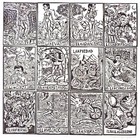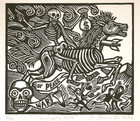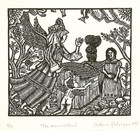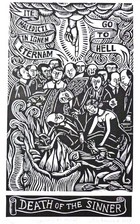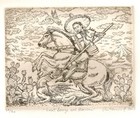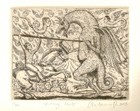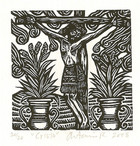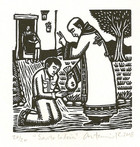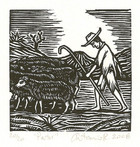Artemio Rodriguez
One look at the graphic art of Mexican Artist Artemio Rodriguez will leave you in no doubt about its inspiration. His teeming black and white studies of galloping ghouls, dancing devils, and sombreroed saints summon up the pamphlet art of Jose Guadalupe Posada, the great turn of the century illustrator, whose prints, featuring sardonic studies of skeletons, known as calaveras (from the Spanish word for “skull”), defined modern Mexican printmaking and influenced the revolutionary mural painters, especially Diego Rivera and Jose Clemente Orozco. Rodriguez has updated Posada’s artistic idiom without losing the satirical sting, making use of religious imagery, drawn from traditional Roman Catholic art and Mexican popular culture.
Rodriguez was born in the village of Tacambaro in the southwestern Mexican state of Michoacan, the son of a farmer-construction worker who spent half of the year away in the United States, harvesting fruit and tobacco. Rodriguez received a scholarship to study agronomy at Mexico’s premier school for agricultural studies just outside Mexico City but never got his degree. He discovered something far more compelling closer to home. Mexican Master Printer Juan Pascoe had opened a workshop in an old hacienda just outside Tacambaro to produce books, using the centuries-old technique of hand press printing. Rodriguez became his apprentice and made his first linocut illustrations there.
Two Rodriguez brothers had already gone to live in Los Angeles, California, and Artemio slipped across the border in 1994 to join them, employing his artistic talents as a housepainter. In his free time he made art at Self Help Graphics & Art, a Latino community arts center in East Los Angeles. The prints from his early years on El Otro Lado (the Other Side) were often nightmarish studies of the American “good life” or nostalgia-laden images like his La Loteria series, reconfiguring the 52 illustrated cards, used in this popular Mexican bingo-like game, where matches are made by picture rather than number. La Loteria II in the Sacred Art Pilgrim Collection presents a"deck" with religious images of Christ, Adam and Eve, and St. Jerome along with a caricatured immigration officer-cum-motorized horse cart, pursuing a fleeing illegal migrant worker.
In 2002, Rodriguez founded his own Los Angeles print shop, La Mano Press. His first publication was, of course, a monograph on Posada. Rodriguez became an ardent advocate for hand printed art and social issues of concern to Mexican migrant workers, converting a 1947 Chevrolet delivery truck into the GraficoMovil, a traveling art gallery, print shop, and movie theater. Rodriguez moved back to his home town of Tacambaro in 2009, where he is currently developing El Huerto (The Orchard) Center for Ecology and Art in an abandoned adobe building on a large garden plot with a spring, which will house a workshop for hand printing, an art gallery, library, store, and compost waste project, promoting ecological gardening.
The Rodriguez prints on religious themes in the Sacred Art Pilgrim cover the gamut from a skeletal Horseman of the Apocalypse, who makes war with a fist full of dollars in the style of Posada, to a Virgin of the Rosary, interceding for tortured souls in purgatory, typical of popular religious art. In The Annunciation, a sumptiously clad Spanish colonial-styled angel appears to a humble peasant woman. Hypocrisy on All Sides transforms El Greco's pious masterwork, The Burial of Count Orgaz, into a satiric scene, belching out hellfire and brimstone. Two etchings provide ironic variations on the legendary battle of St. George and the dragon.
Three small linocuts of Christ, the Holy Thief, and the Shepherd come from a series of 80 prints Rodriguez made to illustrate a collection of haiku-like poems about life in Tacambaro, written in the 1920s by Mexican Poet Jose Ruben Romero. They were published in 2009 in a limited edition, hand-printed by Rodriguez's mentor, Pascoe. Part of the proceeds from the sale of the book will go toward the village’s new ecology and art center.

